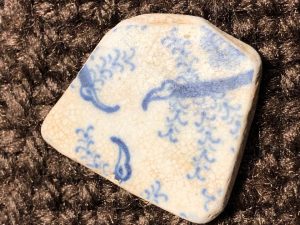Pottery and its Relationship with Humanity
Pottery and its relationship to humanity
Ten thousand years before we became agrarians a man or a women squished some mud that contained a greater amount of clay. (20,000 years ago.)
It had different properties than that of mud that was found along the river bank.
The clay resisted absorption differently than the mud.
The clay had a firmer and smoother texture when wet and also had an adhesive quality.
It could be shaped and could bind together all by itself. They found that mixing seashells and sand helped strengthen the composition.
Prior to this time vessels of containment consisted of pine needles, plants of the salix family (willow) and various reeds, and water vessels made of animal bladders and various animal skins.
Pottery offered a water tight method of containment. It could store liquids for longer periods of time without degradation, provided the pottery was fired.
Nearly 500 hundred years ago …..in 1540 – Francisco de Orellana Bejarano Pizarro y Torres de Altamirano was the first European to travel the length of the Amazon River and its basin starting in Guayaquil, Ecuador.
He was commissioned by Conquistador Francisco Pizarro.
Orellana professed that in his river explorations that he past numerous villages, each village contained hundreds if not thousands of inhabitants.
This account was deemed rather dubious by later historians because there was no longer any people or artifacts to be found in this region to bolster his claim
Their are few stones in the Amazon that can be used for workable tools and most all of their implements were made of wood and plant materials, materials that are highly perishable……nothing remained….there were few objects of techno intrinsic potential.
Until the advent of Li dar? High res imaging. Archeologists had not been digging deep enough in the Amazon soils and deeper than expected was the remnants of the civilizations that Orrella had previously documented.
People could survive and subsist and even prosper in this region that we have only recently come to marginally understand.
These populations may well have been completely destroyed by European diseases even before we knew that they existed.
They had died of European diseases long before we had the chance to document their existence.
Our diseases traveled much faster than our explorers.
POTTERY comes back into this equation.
Terra Pretta is the gold of the Amazon. Terra Preta is not a metal and yet it is the most valuable resource if you plan to farm and survive in this remote region.
Terra Preta is comprised of charcoal and broken pottery all ground up, this mixture ends up within the growing fields of the Amazon.
This combination of charcoal and pottery enhances the poor quality soil, the nitrogen, potassium and calcium found within the soil structure, increase!
Archeologist were startled to find a field of this terra preta and as they continued to look they found not one field but numerous fields.
Was it created by accident or was is a deliberate act of understanding? That has yet to be answered.
The Amazonians were prospering with farming in a region long thought unable.
Today many of these areas are dominated (curiously) by smaller fruit bearing tree rather than the towering mature rain forest trees.
Understand that these trees most probably were planted by a people long since gone. They planted trees that grew fruit, fruit that attracted peccaries and various animals that they hunted. The symbiotic relationship was perfect.
Charcoal and potsherds have been the remnants of most all societies.
Along the London Thames pottery sherds tell a story.
The Roman occupation between 64 A.d. and 240 A.D. leave heating tile and vents made of Roman pottery.
In later years the shoreline gives up sherds of Chinese porcelain. Porcelain was a pottery of higher quality than any European pottery. It was higher fired, it was light years in strength and artisanal advancement.
Finding it reveals that Europeans were now world explorers. The pottery reveals that they have discovered the “Far East”.
Another hundred years have past and in the very same river…Dutch Pottery sherds reveal a nation of Holland imitating and creating a “Dutch Knock off” of Chinese porcelain.
It had neither the strength nor the quality of Chinese porcelain
but it was less expensive than traveling to the other side of the world and commoners were pleased with a cheap facsimile.
Pottery endures even though it is in the forms of broken sherds.
All along the Thames in London you can easily find pipe stems, pipe bowls and without too much effort you can we find a fully intact pipe.
The pipe is pottery. The pipe was more than likely made within a few miles of London and the Thames.
The city was a haven of artisans and craftspersons.
The pipes are exceedingly diagnostic.
They occur in a tempestite event….a time when Sir Walter Raleigh brought back tobacco from the America’s.
Tobacco! People were blowing smoke out of their mouths and nostrils.
The trade became more robust, the quantity of tobacco increased……….the bowls of the pipes got bigger.
The diversity of simple “smoking pipes” reveal the competition of potters and workers of clay.
This was perhaps the very first product of European mass manufacture.
It was the “BIC” razor of it’s time. It was plentiful and it was fully disposable.
Our history is in our trash.
In my small little portion of the world I walk farm fields (300 kilometers from a big city) and find sherds of pottery.
Most often they are referred to as “Fox Lake Incised”. They are 100 B.C. and 1,000 A.D. made of local (rather poor quality) clay and are of hand construction.
As you stoop down to pick up your next sherd of pottery, consider the people that labored to make it and how they toiled and prospered.
billkeitel.com


